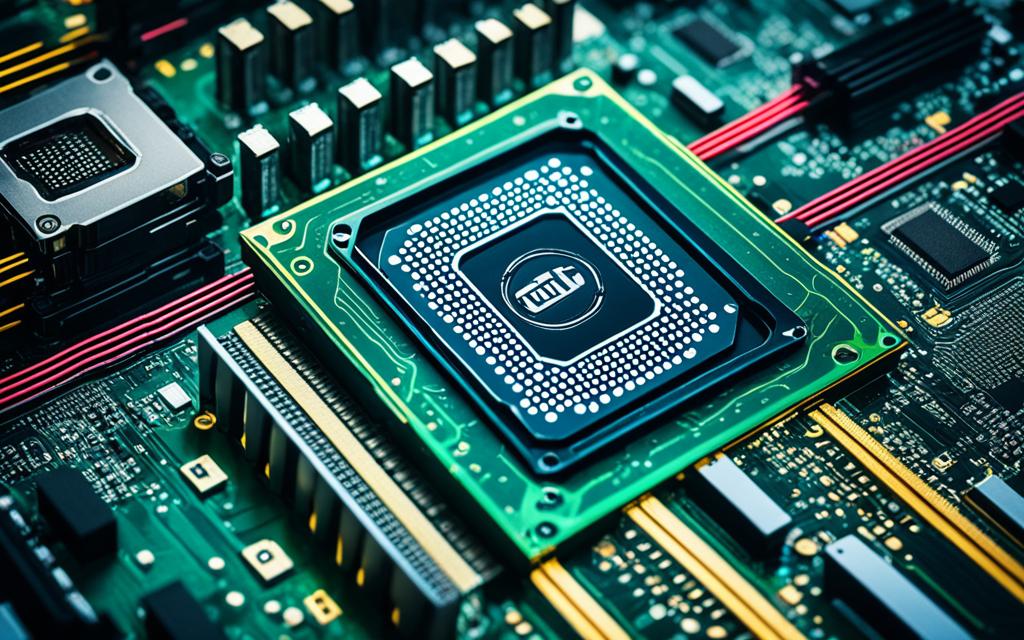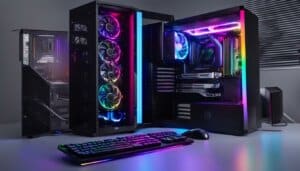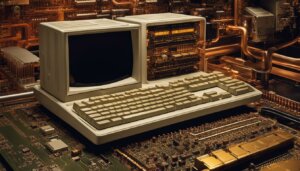Table of Contents
Upgrading your PC with a new graphics card can make your computing experience much better. But it’s vital to check if they match. Let’s dive into how to find the right graphics cards for your PC with real data.
Looking into graphics card compatibility involves a few steps. First, you need to see what slot your motherboard has. Most new computers use PCI Express 3.0 slots which work best. Even if your PC is older, PCI Express 3.0 cards will still fit because they’re compatible with PCI Express 2.0 slots1.
Next, think about your PC’s power supply unit (PSU). Different graphics cards use different amounts of power. Your PC’s PSU is 260 watts. So, you’ll need a card that needs less power than that for everything to run smoothly2.
Also, the size of the graphics card matters as well as the space in your PC’s case. Slim PCs might need low-profile cards, like the MSI GeForce GTX 1050 Ti 4GB LP or the GTX1650. Make sure the card’s length and slot requirements fit your case2.
Moreover, ensure the graphics card works well with your CPU and RAM. High-end graphics cards usually match well with modern AMD Ryzen 7 and Intel Core i7 processors. Also, remember to check your motherboard’s PCI Express slots and the power supply suggestions from the card’s maker13.
Key Takeaways:
- Make sure your motherboard’s slot type matches, with most modern PCs using PCI Express 3.0 slots1.
- Look at your PC’s PSU wattage, here it’s 260 watts, to pick a graphics card that fits the power limit2.
- Confirm the graphics card’s size and your PC case’s space are compatible2.
- Check if the graphics card and other parts like the CPU and RAM match. Also consider the power supply wattage range from the card’s manufacturer13.
Checking Graphics System Compatibility on Windows
To check if your graphics system works well on Windows, you can use some built-in tools. These tools tell you about your graphics card. They show if it fits well with new software and games.
Windows Task Manager: You can open Windows Task Manager by pressing Ctrl + Shift + Esc. Another way is to right-click on the taskbar and choose “Task Manager.” Go to the “Performance” tab and click on “GPU” to see your GPU’s activity and memory. If you have more than one GPU, they will be listed as “GPU 0,” “GPU 1,” and so on4.
System Information: System Information gives you a full look at your computer’s hardware and software. Press the Windows Key, type “System Information,” and press enter. Here, under “Components” then “Display,” you can see details about your GPU. This includes the model, who made it, and the driver version4.
PowerShell: For those who like using commands, PowerShell is a good choice. Open it by pressing the Windows Key and typing “PowerShell.” Use the command “Get-CimInstance win32_VideoController” for info about your graphics card. This includes its name, manufacturer, and which drivers it uses4.
DirectX Diagnostic Tool (DxDiag): DxDiag is another tool that tells you about your system’s graphics. Press the Windows Key, type “dxdiag,” and hit enter. In the DxDiag window, under the “Display” tab, you’ll find details about your GPU. This includes the card’s name, its maker, and how much display memory it has4.
Also, there are tools like HWiNFO64 that give real-time GPU data. They show the temperature and clock speeds. This helps you understand how your graphics card performs. It can also help when setting your card for the best performance4.
In summary, Windows has many tools to check if your graphics system is up to date. Tools like Windows Task Manager, System Information, PowerShell, and DxDiag make it easy. They help you get all the info you need about your graphics card. This ensures it will work with the software and games you use4.
Compatibility with Older PCs
It might surprise you, but older PCs can work well with the latest graphics cards. This includes powerful options like the Nvidia RTX 2080 Ti and AMD Radeon RX 5700 XT. Yet, to make this work, some important conditions must be met.
Key Requirements for Compatibility
- A PCIe x16 slot is needed on the motherboard. It’s a must-have for connecting new graphics cards5.
- The PC case must have enough room. It should fit the graphics card’s length and width, including any extra cooling features or backplates5.
- A power supply with PCIe Graphics connectors is crucial. Modern graphics cards need power through 6-pin, 8-pin, or 6+2-pin connectors. Having the right connectors ensures the graphics card gets enough power5.
- The CPU and RAM should be fast enough to match the graphics card. This stops any slow-downs. The CPU must handle modern games and apps. And the RAM needs to be quick and big enough for the best performance5.
By meeting these conditions, older PCs can use the newest graphics cards. This boosts gaming and multimedia without a full system upgrade. Backward compatibility is amazing for giving old computers a new lease of life.
PCIe x16 Compatibility
Graphics card compatibility heavily relies on the PCIe x16 slot of your motherboard. This slot accommodates graphics cards, especially those needing expansion slots. It’s the common slot type for modern graphics cards6.
PCIe x16 slots are known for amazing backward compatibility. They work with PCIe cards from versions 1.0a/1.1 up to 4.0. There’s potential for future PCIe 5.0 and 6.0 support, although some issues might affect compatibility6.
A PCIe 3.0 graphics card will work in a motherboard with a PCIe x16 2.0 slot. PCIe x16 slots support cards from older versions thanks to their backward compatibility. This means using a PCIe 3.0 card on an older motherboard is hassle-free6.
High-end graphics cards need proper power supplies. They usually require at least a 600W power supply unit (PSU) for smooth running. Your PSU should have extra capacity and not run at over 80% of its maximum to avoid power issues6.
Some graphics cards need two PCIe power connectors. Connecting each to a different 12V rail helps with power distribution. This is key for high-draw cards to perform steadily without overloading the PSU6.
Bandwidth Requirements for Different Pixel Formats
| Pixel Format | Pixel Depth | Bandwidth Requirement |
|---|---|---|
| 4:4:4 | 8-bit | 1000 MB/s |
| 10-bit | — | |
| 4:2:2 | 8-bit | — |
| 10-bit | 250 MB/s | |
| 4:2:0 | 8-bit | — |
| 10-bit | — |
The table shows estimated bandwidth needs for various pixel formats. Looking at 8-bit and 10-bit depths in formats like 4:4:4 helps plan your setup. Knowing the bandwidth your setup requires is vital for top performance. Bandwidth formula: BW = resx x resy x fps x kpixel_factor7.
Using a 16-bit YUV format might cut down on bandwidth but could affect capture quality. Finding the perfect balance between bandwidth and quality matters for your needs7.
PCIe x16 slots ensure most graphics cards work well across different versions. It’s important to check your power supply and distribution for high-end cards to run smoothly. Knowing bandwidth needs for various formats also helps in optimizing performance for content capturing or streaming67.
Clearance Space and Case Size
When you’re setting up your PC, the space for your graphics card is crucial. This is especially true for smaller PCs or pre-built ones. They often have size restrictions8.
To find out how long your GPU can be, look at your case manual. Or, measure the space yourself. Make sure there’s extra room for a good fit8.
You must also look at your graphics card’s width and height. The case size is important too. Some cards are wider, even if they use the same slot. Always check the actual sizes8.
For instance, some famous GPUs are about 47mm to 49.75mm wide. These are in the 2.5-slot category. Check that your case fits these sizes well8.
Some cases, like the Cooler Master NR200P, can hold bigger graphics cards. This case fits cards up to 330mm long, 156mm high, and 60mm wide8.
To match your GPU with your case, use online resources. Websites like Google and PCPartPicker offer helpful info. They have details on GPU sizes, compatible cases, and reviews8.
Keep in mind, the space around your GPU affects cooling. Enough room helps avoid overheating. This keeps your PC running smoothly8.
Lastly, think about what you want from your PC. Your needs might affect the GPU features you choose, such as fan numbers. It’s about finding the right mix of performance, size, and fit for you8.
| Clearance Space and Case Size | Statistical Data |
|---|---|
| Approximate GPU sizes | Models with a single fan to ones with three fans |
| GPU slot configurations | Single-, dual-, and triple-slot designs |
| Dual-slot GPUs | Range from occupying exactly two slots to up to 2.75 slots |
| Width variations of GPUs | Exist among GPUs despite sharing the same slot classification |
| Popular GPU widths | Around 47mm to 49.75mm, falling within the 2.5-slot category |
| Case example | Cooler Master NR200P – supports graphics cards up to 330mm in length, 156mm in height, and 60mm in width |
Power Supply and Connectors
When you’re adding a new graphics card to your computer, remembering to check your power supply and connectors is key. The power supply gives your graphics card the electricity it needs to work well and without issues.
As new graphics cards often need more power, you’ll need the right power connectors. Most power supply units (PSUs) come with marked cables. It makes finding the right PCIe power cables for your graphics card simple. These cables are usually 6-pin or 8-pin and provide power directly to the card.
Make sure your power supply has the right 6- or 8-pin connectors for your graphics card. Don’t try to change connectors or use adapters, as it’s unsafe. Using adapters can also make your system less stable and affect its performance.
Some top-end GPUs, like Nvidia’s GeForce RTX 40-series, need a 12VHPWR connector. This connector is only on the latest ATX 3.0 PSUs. Make sure your PSU has this connector if your graphics card requires it.
If your older PSU lacks 12VHPWR ports, there are ways to adapt. Nvidia GPUs that need the 12VHPWR connector often come with an adapter cable. Still, you should check how well these adapters work, as they could affect your system’s stability and performance.
Not all modern graphics cards use the 12VHPWR connector. Many still need traditional PCIe cables for power. It’s very important to check what your graphics card needs by looking at the manufacturer’s specifications.
Choosing the right power supply unit means looking at connector types and how much power your system needs. Your PSU should meet or beat the graphics card manufacturer’s minimum wattage. For the best and most reliable performance, pick a PSU with more wattage than suggested.
There are specific power supply unit recommendations for gamers. Examples include the Cooler Master V750 Gold i and MSI MPG A750G. They are great because they have 80 Plus Gold certification, let you manage cables easily, and support the necessary 12VHPWR cable.
Matching your power supply and connectors with your new graphics card ensures the best performance and stability. Choosing the right connectors and enough wattage can greatly improve your gaming or graphic work.
Power Supply and Connectors Checklist:
| Considerations | Guidelines |
|---|---|
| Identifying the correct cables | Most modern PSUs come bundled with labeled PCIe cables for graphics cards9 |
| Power connector requirements | Check the power requirements of your graphics card and ensure your PSU has the suitable 6- or 8-pin PCIe Graphics (PEG) connectors9 |
| Compatibility with advanced GPUs | Verify if your PSU has a 12VHPWR connector for graphics cards, such as Nvidia’s GeForce RTX 40-series9 |
| Adaptation options for older PSUs | If your PSU lacks 12VHPWR ports, check if a 12VHPWR adapter cable is included with your graphics card or consider alternative solutions carefully910 |
| Power supply wattage estimates | Ensure your power supply meets or exceeds the minimum and recommended wattage estimates specified by the graphics card manufacturer9 |
| Recommended power supply units | Consider reliable power supply units like the Cooler Master V750 Gold i and MSI MPG A750G, with features like 80 Plus Gold certification, modular cable management, and appropriate 12VHPWR cable support9 |
Conclusion
Upgrading your PC with the right graphics card boosts performance and gaming skills. But, it’s vital to check if the card fits your PC’s needs first. This means looking at graphics system compatibility, PCIe x16 slot availability, space in your PC, power supply connectors, and how well your PC will run with it.
Nvidia’s RTX 4000 and 3000 Series GPUs use PCIe 4.0 connectors. Meanwhile, the latest Z790 motherboards for Intel have PCIe 5.0 slots. It’s good news because PCIe lets newer graphics cards work with older slots. Most of these cards need a PCIe x16 slot on the motherboard.
Heavy-duty graphics cards like the RTX 3000 and 4000 Series require a lot of space and power. For example, the RTX 3090 needs a 350-watt power supply, and the RTX 4090 needs 450 watts. You should have at least 750 watts for an RTX 3090 and 850 watts for an RTX 4090. For these cards, you’ll want Ryzen 7 or better CPUs for AMD, or Core i7 or better for Intel. Also, these cards usually have DisplayPort and HDMI for connecting screens.
Other crucial factors include VRAM and refresh rate, based on data11. Games these days need a graphics card with at least 4GB of VRAM. For smooth play, pick a card that supports at least a 144 Hz refresh rate. If you’re into overclocking, consider cards with liquid cooling. Also, high-end cards might need extra 6-pin or 8-pin power connectors.
So, before you buy a graphics card, make sure it’s fully compatible with your PC. This prevents any issues and helps you get the best gaming experience possible.
FAQ
How can I check the compatibility of my graphics system on Windows?
To see if your graphics system works with Windows, press the Windows Key. Then type “dxdiag” and hit enter. Click the “Display” tab and find the “Feature Levels” under Drivers. If it doesn’t list “11_0”, your system isn’t compatible.
Can modern graphics cards work with older PCs?
Yes, new graphics cards like the Nvidia RTX 2080 Ti and AMD Radeon RX 5700 XT can fit in PCs from last decade.
What are the key requirements for graphics card compatibility?
For a graphics card to work, you need a PCIe x16 slot on the motherboard. Your PC case must have enough space. Also, you need a power supply with 8- and 6-pin PCIe Graphics (PEG) connectors. Fast CPU and RAM are important to avoid slowing down the card.
Is PCIe x16 slot backward compatible?
Yes, PCIe x16 slots work with older versions too, making them greatly flexible. They fit any card and support versions from 1.0a/1.1 up to 4.0. They might even work with future 5.0 and 6.0 standards.
How can I determine if my PC case has enough clearance space for a new graphics card?
Check your case manual or measure the space with a ruler to find out your GPU’s maximum length. It’s good to have some extra space for an easier fit.
Do I need a specific power supply for a new graphics card?
When you get a new graphics card, your power supply needs the right connectors. It should have 6- or 8-pin PCIe Graphics (PEG) connectors. Avoid changing connectors for safety. Check PSU wattage to see if it’s enough.
How can upgrading my PC with a compatible graphics card enhance performance?
A new graphics card can make your PC run faster, especially for games. If it matches your system’s requirements, your PC’s power will be fully used.
Source Links
- https://www.alphr.com/check-graphics-card-compatible-pc/ – How to Check if a Graphics Card Is Compatible With Your PC
- https://forums.tomshardware.com/threads/what-graphics-card-is-compatible-with-my-pc.3735857/ – [SOLVED] – What graphics card is compatible with my PC?
- https://www.cgdirector.com/graphics-card-compatibility/ – How to Check Graphics Card Compatibility with your PC?
- https://www.howtogeek.com/414201/how-to-check-what-graphics-card-gpu-is-in-your-pc/ – How to Check What Graphics Card (GPU) Is in Your PC
- https://softwareg.com.au/blogs/computer-hardware/which-graphics-cards-are-compatible-with-my-motherboard – Which Graphics Cards Are Compatible With My Motherboard
- https://www.techadvisor.com/article/727180/how-to-know-if-a-graphics-card-is-compatible.html – How to know if a graphics card is compatible
- https://video.matrox.com/en/media/guides-articles/matrox-pci-and-pcie-guide – Guide to Types of Expansion Slots and Add-In Cards | Matrox Video
- https://www.cgdirector.com/gpu-clearance-explained/ – Will My GPU Fit In My Case? [GPU Clearance Explained]
- https://www.xda-developers.com/how-connect-gpu-to-psu/ – How to connect a GPU to the PSU
- https://www.linkedin.com/advice/1/how-do-you-check-your-gpu-power-connector – How do you check if your GPU power connector is compatible with your PSU and motherboard?
- https://gamesgear.pcquest.com/gaming-laptops/how-to-choose-the-right-graphics-card-for-seamless-performance/ – How to Choose the Right Graphics Card for Seamless Performance? – GamesGear








